Rubber Tree Plant Care: Growing Rubber Fig (Ficus Elastica)
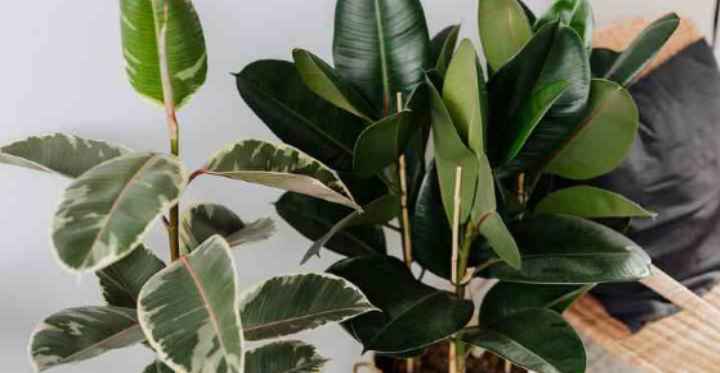
The rubber tree plant— botanical name is Ficus elastica—is a hardy houseplant that is very easy to care for. The plant also has names such as Indian rubber tree, rubber fig, and Indian rubber bush. Its thick, glossy, leathery green leaves and fast, tall growth mean that rubber plants add to the aesthetics of any room.
Ficus elastica is one of the 800 species of trees and shrubs in the genus Ficus. The ornamental rubber tree houseplants can grow as a small desktop plant or a large rubber indoor tree to add visual height. Some of the attractive species of these Ficus plants have variegated green and creamy white leaves.
How to care for Ficus elastica: The rubber tree plant thrives in bright, indirect sunlight, growing in slightly moist soil and average room humidity. Water the rubber plant when the top 2” (5 cm) of potting soil is dry and feed every two to four weeks in the growing season. Ideal indoor temperatures for the rubber fig plant are between 60°F and 75°F (15°C – 24°C).
The common name of the species—rubber tree or rubber plant—comes from its milky white sap that can be used to make rubber. This white sap oozes out of the rubber plant’s leaves and woody stems if they’re cut or scratched.
Although the rubber tree is a flowering species of plant, it rarely—if ever—blooms indoors. If the rubber plant does flower, the blooms are insignificant.
The attractive feature of Ficus elastica is its leathery leaves. Some cultivars such as the ‘Burgundy’ and ‘Black Prince’ have dark red or purple, almost black leaves.
In this article, you’ll find tricks and tips on caring for rubber tree plants at home. At the end of the care guide, you will find answers to many questions about caring for these ornamental, leafy houseplants.
Varieties of Rubber Tree Plant (Ficus Elastica)
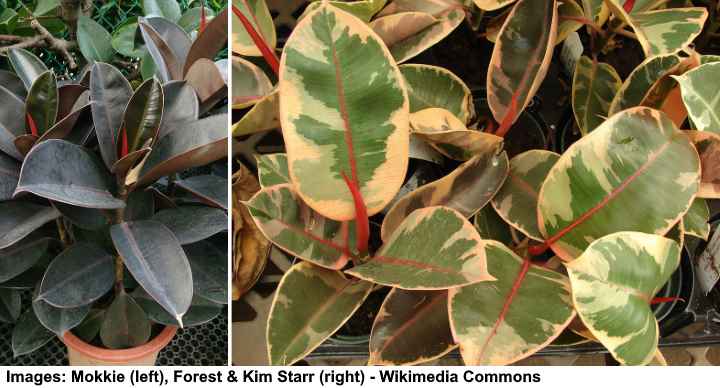
Rubber tree plants include several cultivars ranging in leaf color, including variegated cultivars (right picture). The rubber plant is considered to be one of the plants that bring good luck according to the Feng Shui
Apart from the standard Ficus elastica with its shiny green leaves, there are several varieties of rubber plant. Some popular species of rubber trees include:
- Ficus elastica ‘Robusta’—The ‘Robusta’ cultivar has large oval leaves that are shiny and dark green.
- Ficus elastica ‘Burgundy’—The deep burgundy colored leaves look almost black. The new foliage is bright red, which adds to this plant’s striking appearance.
- Ficus elastica ‘Tineke’—A popular variegated rubber plant with glossy leaves in shades of green and white with red veins.
- Ficus elastica ‘Ruby’—This variegated Ficus cultivar has stunning red-pink and white leaves with hints of green.
- Ficus elastica ‘Doescheri’—This rubber plant has elongated oval leaves with variegation. Depending on the cultivar, leaf colors can be green and pink, green and white, or shades of green and lime-green.
How to Care for Ficus Elastica (Rubber Tree Plant)
With the right care, your baby rubber plant will soon grow into a beautiful houseplant. Most varieties of Ficus elastica grow well in various lighting conditions. However, variegated rubber plants need bright light. You should only water the plant as often as the soil partly dries.
Let’s look in more detail at how to look after this plant at home.
How Much Light Does Rubber Fig Plant Need?
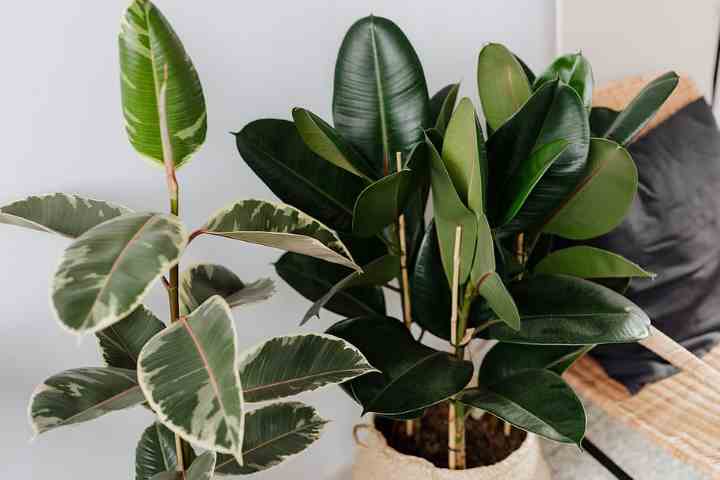
Grow your ficus elastica houseplant in bright indirect light
Ficus elastica plants grow best in bright light but protected from direct sunlight. An ideal location for a compact rubber plant would be an east-facing windowsill. If you have to place a Ficus plant pot in a west- or south-facing room, keep it well away from the window or place behind a sheer curtain.
All types of rubber plants (Ficus Elastica) need at least medium light to grow fast. These are not houseplants that grow well in total shade. You may notice that growth becomes leggy if the indoor trees don’t get enough light. If foliage appears sparse on the woody stems, try moving the plant’s container to a brighter location.
The best advice for growing variegated rubber plants at home is to put them in a well-lit spot. Plenty of bright light is crucial to help keep the creamy-yellow, white, or bright pink leaf patterns vibrant and beautiful. Varieties such as Ficus elastica ‘Black Prince’ or ‘Burgundy’ with darker leaves will grow well in low to medium light.
The Best Potting Soil for Growing Rubber Tree Plants Indoors
For rubber plants to thrive indoors, they need to grow in a well-aerated potting mix that has excellent drainage. Water must drain quickly through the soil to prevent any damage to the plant’s roots. The best type of growing medium should contain equal quantities of peat, pine bark, and perlite.
The ingredients for the potting soil help to keep the roots hydrated without becoming rotten. Organic matter, such as peat, retains moisture. The loose material such as bark chips and perlite help to improve drainage. This potting soil combination creates an ideal medium for growing rubber trees indoors.
There are several ways to tell if your potting soil for rubber plants is ideal. For example, the water shouldn’t create puddles on the soil’s surface. Also, the water should drain reasonably quickly and easily pour out through the plant pot’s drainage holes. If water flows poorly, you will have to repot your rubber plant to loosen the soil.
Repotting helps to boost plant growth in these two ways:
- Refresh old soil that has become compacted and lost nutrients.
- Transfer to a larger pot if the large indoor tree has become rootbound.
How to Water Rubber Tree Plants
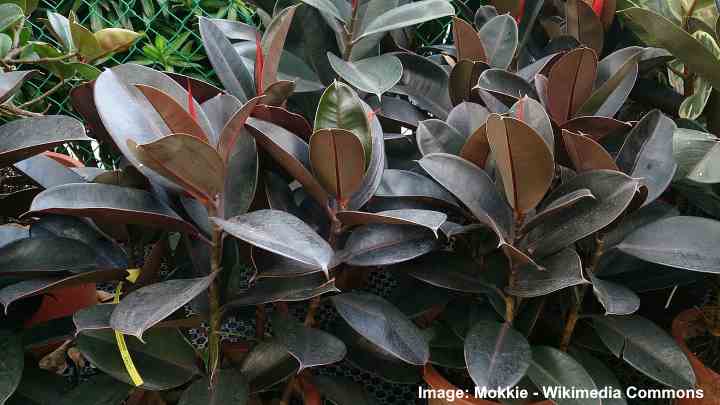
Water your rubber plant when the top soil has dried out
Proper watering is crucial to the health of your rubber plant. To water your indoor Ficus, give the soil a good drenching. Soaking the soil allows the roots to get hydrated. But you need to guard against overwatering. So, only water the plant when the top 1” to 2” (2.5 – 5 cm) of soil is dry.
How often should you water a rubber plant? The simple answer is to water rubber trees as often as the soil partially dries out. To tell when it’s time to water your plant, poke your finger about 2” (5 cm) into the soil. If the medium is dry, then it’s time to give your plant a deep watering.
A rubber plant that sits in water for too long usually ends up suffering. You can avoid a dying rubber plant by allowing all the water to drain from the soil. Also, make sure that water doesn’t collect in the saucer.
Here are several factors that affect how often you need to water your plant:
- Season and climate—Water Ficus plants less often in winter than in summer because growth becomes dormant. Always let soil moisture be your watering guide.
- Type of pot—Clay, terracotta pots allow more moisture to evaporate, so you have to water the plant more frequently than ones in plastic containers.
- Rootbound—When a plant becomes rootbound, the roots fill up most of the pot. This causes the growing medium to become denser, and you have to water rubber plants less often. Plants that get rootbound tend to suffer from overly-damp soil and root rot.
Top care tip when watering rubber plants: Allow water to sit out overnight before watering. This allows harmful chemicals in tap water to evaporate and get the water up to room temperature—ideal for watering any type of houseplant.
Room Temperature Requirements for Ficus Elastica
Average indoor room temperatures are ideal for growing rubber tree plants, as long as the temperature is even. The perfect temperature range is between 60°F and 75°F (15°C – 24°C). However, the rubber plants will still grow—albeit slower—in temperatures down to 55°F (12°C).
Although rubber trees are quite hardy indoors, they don’t like cold drafts. In summer, keep the plants away from drafty windows or doors and out of the air-conditioning flow. It’s also crucial to avoid sudden fluctuations in temperature. So, don’t place rubber plants near hot radiators in winter.
Ficus elastica rubber tree plants grow outdoors in USDA zones 10 to 12. You should plant your rubber plants in a bright spot where they get dappled sunlight.
You can still grow rubber plants in pots outside during summer if you live in temperate climates. Be careful when the temperature drops below 50°F (10°C) as the plant’s roots can suffer from dampness and cold.
Rubber Tree Humidity Requirements
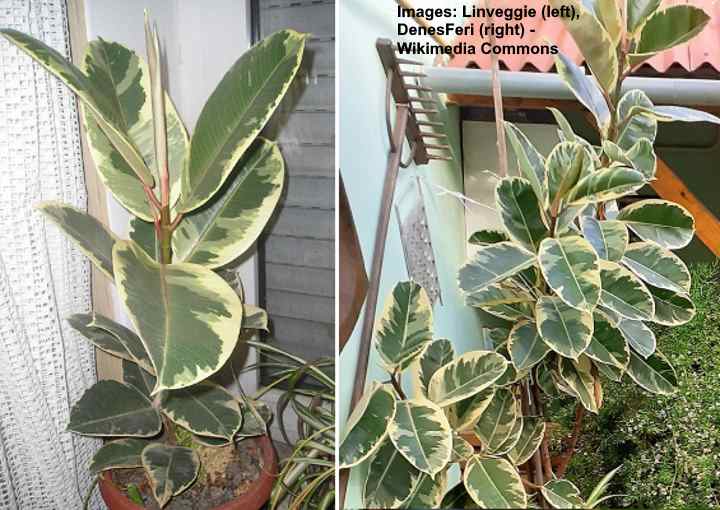
Rubber tree plants grow well in an average room humidity. In the picture: variegated Ficus elastica
Average room humidity is ideal for rubber plants to grow vibrantly and healthy. Sometimes, you may need to humidify the plant when growing indoors. For example, you will have to mist its leaves during hot, arid summers. Also, household heating in winter tends to dry the air; therefore, misting weekly in winter is a good idea.
Apart from misting the leaves occasionally, you can wipe them with a damp cloth. Cleaning the leaves this way adds some moisture to the plant and also cleans dust from the glossy, large, broad leaves. If your home air is especially dry, place the rubber plant on a humidifying pebble tray.
This is how to create a pebble tray to humidify Ficus elastica plants:
- Put a layer of small pebbles or decorative stones in a deep tray.
- Fill the tray with water until it reaches half-way up the stones.
- Place the rubber tree plant pot on the pebbles, ensuring the water isn’t in direct contact with the soil.
- As the water evaporates, it creates a humid environment for your rubber plant to thrive.
Rubber Plant Flowers
Ficus elastica is a type of flowering plant that is native to Southeast Asia. However, houseplant owners keep rubber plants for their glossy foliage, not their flowers. The flowers on this type of fig plant are small and green, not fragrant, showy, or bright. It is also rare if a rubber plant flowers indoors.
Some people confuse the new leaf growth for flowers on the plant. New growth on many rubber plant cultivars looks like a bright red sheath, which then gives way to new leathery leaves.
Rubber Tree Plant Growth Rate

Rubber plants grow faster in bright light and warm temperatures. In this image: Ficus elastica ‘Burgundy’
All species of Ficus elastica plants have a moderately-fast growth rate. A baby rubber tree will grow quickly, especially in spring, into a larger plant with broad oval leaves. The optimal conditions for fast rubber tree growth are bright light, regular feeding, and warm temperatures.
During late fall and winter, the plant’s growth rate slows down. Also, you’ll notice that their growth almost stops if the rubber plants become rootbound. To help keep growth healthy, curb feeding in winter and repot rootbound plants in spring.
Without pruning, rubber plants can quickly grow into large indoor trees that give a stunning visual accent to any room or office. In an indoor environment growing in containers, rubber plants can grow to between 6 and 10 feet (1.8 – 3 m) tall.
Feeding Indoor Rubber Tree
During the growing season—from March until September—feed the rubber tree plant every two to four weeks. Use a suitable houseplant fertilizer that is diluted to half strength. Don’t feed the plant during winter, as this could cause the plant to die from overfeeding.
Pruning a Rubber Tree
Pruning a Ficus elastica helps to encourage bushy growth and control its height. To prune the plant, trim back the top of the plant to the height desired. Cutting off stems that have dead or dying leaves improves the plant’s appearance. To encourage fuller, compact growth, prune the plants stems just above the node.
Ficus Elastica Propagation
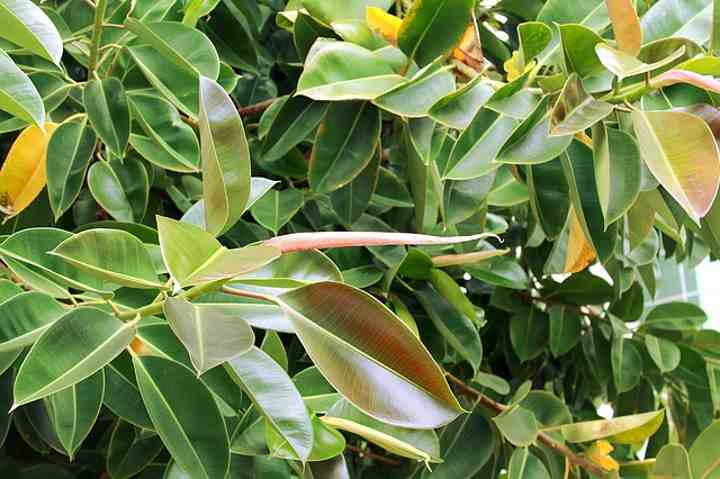
Propagating a rubber plant is done by stem cutting. This involves cutting the main stem and leaving one leaf on the stem. Milky sap will ooze from the stem for about 30 minutes, so wait until that has stopped and then wipe the stem clean.
To grow a new plant, cut off the top of the stem about 6” (15 cm) long so that there is one leaf on it. Put the stem cutting in moist perlite to root, and place in a warm, bright location. The temperature for the plant to take root should be between 70°F and 75°F (21°C – 24°C).
Repotting an Indian Rubber Tree Plant
Eventually, you will need to transfer the rubber plant to a new, larger container to keep growth healthy. Repotting a Ficus plant in spring also gives you a chance to refresh the potting soil and check for rotting roots. All you need to do is prepare the appropriate potting medium and transfer the plant.
When you remove the rubber plant from its existing container, untangle the roots. Look for brown, mushy roots and trim with sterile scissors as necessary. After planting the rubber tree in its new container, thoroughly water the plant and put it in bright, indirect light.
Is Ficus Elastica (Rubber Plant) Toxic?
Rubber trees are toxic to animals and household pets such as cats and dogs. The American Society for the Prevention of Cruelty to Animals (ASCPA) says that Indian rubber plants contain poisonous enzymes ficin and ficusin. So, keep the plant away from dogs and cats. (1)
Pests and Disease Affecting Rubber Tree Growth
Species of Ficus elastica are hardy houseplants that are reasonably resistant to pests. The most common types of plant pests you might find on your fig plant are scale, spider mites, or mealybugs. Usually, a neem oil solution can help to get rid of these indoor plant pests.
Please read this article on how to eliminate houseplant pests naturally to know what to do about scale insects, mealybugs, or spider mites.
Raised white dots on some types of rubber plants can be mistaken for pests. However, the white bumps are normal and nothing to worry about.
FAQs About Caring for Rubber Tree Plant Indoors
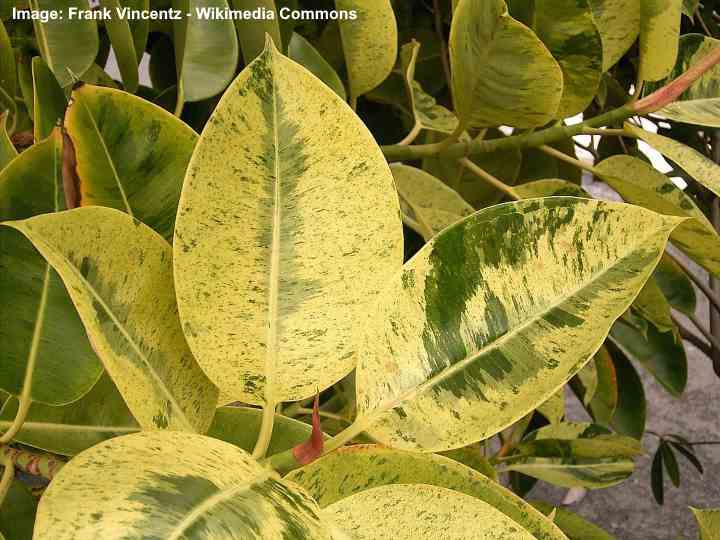
Picture of Ficus elastica ‘Shivereana’
Why are rubber plant leaves curling?
Most likely, curling leaves are a sign of overwatering a rubber tree plant. Usually, the leaf growth should resolve itself if you leave the soil to dry out. Growing in hot temperatures above 85°F (29°C) could also cause Ficus plant leaves to curl. If the leaves curl and then drop, this could be due to exposure to frost.
How to make a rubber plant bushy?
Rubber plants that become leggy need pruning to encourage bushy growth. Legginess of the plant can happen when there’s not enough sunlight. Cut back the stems just above the node to get a bushy rubber plant with compact growth. Also, keep the plant in a brighter location to avoid leggy growth in the future.
Why are my rubber plant leaves falling off?
Overwatering rubber trees is the most common reason for leaf drop. Leaves start falling if the potting mix is too damp or if the plant has been sitting in water. In extreme cases, you may have to repot the plant with fresh soil to help save it from dying. After that, only water the plant when the soil partly dries.
Why are ficus leaves turning yellow?
There are several reasons why rubber plant leaves can turn pale and start to yellow. First, it’s natural that old leaves die and fall off. However, if many leaves are yellowing, it could be due to too much water, soggy soil, or not getting enough light. Addressing the causes should help to revive your plant.
Related articles:
